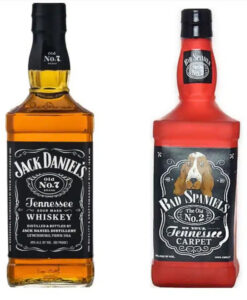Sorry, Puppy, But the Whiskey Ain’t Playin’ Anymore
By James Harris | July 26, 2023
The Supreme Court has issued its opinion in the trademark case Jack Daniel’s Properties, Inc. v. VIP Products LLC, June 8, 2023 (Slip Opinion). Jack Daniel’s makes the best-selling, and arguably most well-known, whiskey in the United States. VIP makes dog toys. In this case, a chewable dog toy that closely mimics the well-known (and trademarked) shape of a Jack Daniel’s whiskey bottle. Jack Daniel’s has also trademarked “Jack Daniel’s,” “Old No. 7,” the arch of their logo, and the stylized, filigreed label. All were closely copied—or changed slightly by a play on words—in the toy, such that any dog might be fooled as to the origin of the toy.

The wording on the dog toy parodies that of the whiskey bottle: “Jack Daniel’s Old No. 7 Tennessee Sour Mash Whiskey” becomes “Bad Spaniels The Old No. 2 on Your Tennessee Carpet.” “40% alc. by vol. (80 proof)” becomes “43% poo by vol. 100% smelly.” These puns may seem amusing, but Jack Daniel’s was not amused, and sent VIP a demand letter. VIP responded by filing a declaratory judgment suit.
VIP defended its design based on First Amendment protections for “expressive works.” In VIP’s view, because the dog toy is a parody, VIP could rightfully use Jack Daniel’s famous marks. VIP also relied on a Second Circuit case, Rogers v. Grimaldi, that calls for dismissal of a trademark infringement claim for an expressive work, unless the mark owner can show either that the use has no artistic relevance to the underlying work or that it explicitly misleads as to source. The Ninth Circuit was persuaded, finding that because VIP’s product commented humorously, the use was noncommercial despite its use to sell a product.
Justice Kagan, delivering the opinion of the Court, did not rely on Rogers. “Without deciding whether Rogers has merit in other contexts, we hold that it does not when an alleged infringer uses a trademark in the way the Lantham Act most cares about: as a designation of source for the infringer’s own goods.” Slip Op. at 10. The Court then explained that the Rogers test—which it was not endorsing—is limited to uses of marks in a “non-source-identifying way.”
The Court acknowledged that trademarks are often expressive and source-identifying. But an expressive use, like parody, cannot be used as a protection when the mark is also being misused to designate source. This is good to know if you think your mark is being misused, and also provides useful guidance for those hoping to use parody in a product.
The case was remanded back to the District Court to determine, consistent with the opinion, the factual issue of likelihood of confusion. And in case your dog was confused, whiskey is strictly for humans.
